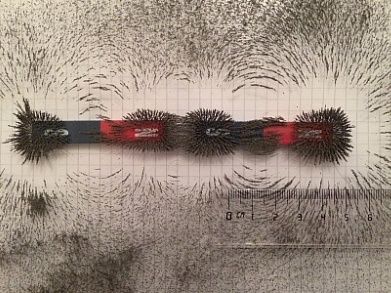Making ferromagnets stronger by adding non-magnetic elements
Researchers at the U.S. Department of Energy's Ames Laboratory discovered that they could functionalize magnetic materials through a thoroughly unlikely method, by adding amounts of the virtually non-magnetic element scandium to a gadolinium-germanium alloy.
It was so unlikely they called it a "counterintuitive experimental finding" in their published work on the research.
"People don't talk much about scandium when they are talking magnetism, because there has not been much reason to," said Yaroslav Mudryk, an Associate Scientist at Ames Laboratory. "It's rare, expensive, and displays virtually no magnetism."
"Conventional wisdom says if you take compound A and compound B and combine them together, most commonly you get some combination of the properties of each. In the case of the addition of scandium to gadolinium, however, we observed an abrupt anomaly."
Years of research exploring the properties of magnetocaloric materials, relating back to the discovery of the giant magnetocaloric effect in rare earth alloys in 1997 by Vitalij Pecharsky and the late Karl Gschneidner, Jr., laid the groundwork for computational theory to begin "hunting" for hidden properties in magnetic rare-earth compounds that could be discovered by introducing small amounts of other elements, altering the electronic structure of known materials.
"From computations, we projected that scandium may bring something really unusual to the table: we saw an unexpectedly large magnetic moment developing on its lone 3d electron," said Ames Laboratory Associate Scientist Durga Paudyal. "It is the hybridization between gadolinium 5d and the scandium 3d states that is the key that strengthens magnetism with the scandium and transforms it to a ferromagnetic state."
"Basic research takes time to bear fruit. This is an exemplary case when 20 years ago our team started looking into what are called the 5:4 compounds," said Ames Laboratory group leader and Iowa State University Distinguished Professor Vitalij Pecharsky. "Only now we have learned enough about these unique rare earth element-containing materials to become not only comfortable but precise in predicting how to manipulate their properties at will."
The discovery could greatly change the way scandium and other 'conventionally' non-magnetic elements are considered and used in magnetic materials research and development, and possibly creates new tools for controlling, manipulating, and functionalizing useful magnetic rare-earth compounds.
Original publication
Other news from the department science

Get the chemical industry in your inbox
By submitting this form you agree that LUMITOS AG will send you the newsletter(s) selected above by email. Your data will not be passed on to third parties. Your data will be stored and processed in accordance with our data protection regulations. LUMITOS may contact you by email for the purpose of advertising or market and opinion surveys. You can revoke your consent at any time without giving reasons to LUMITOS AG, Ernst-Augustin-Str. 2, 12489 Berlin, Germany or by e-mail at revoke@lumitos.com with effect for the future. In addition, each email contains a link to unsubscribe from the corresponding newsletter.




























































